Why did Nat Turner “confess”?
Turner sought to carry on in words the work he had begun with a sword.
This blog has been blessed with a few recent posts on teaching antebellum classics, such as one on Frederick Douglass and one on Maria Stewart. In this spirit, I want to think about Nat Turner’s Confessions. In particular, I want to ask a question that came up recently in teaching the original: why exactly did Turner confess?
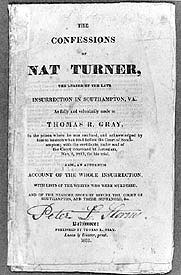
First, terminology. We are used to understanding the term “confession” as an admission of guilt. But in Turner’s day the word could have meant several things. It generally referred to any acknowledgment of the truth of a statement, not necessarily self-revelation of one’s own sins. In the early nineteenth century, the word often signified a declaration of religious belief. “Confession of faith” appeared in innumerable contemporary treatises on church doctrine, for example.
Perhaps Turner’s “confession” should thus be understood more as a profession of faith than as an admission of guilt. This tradition goes back to St. Augustine of Hippo, whose own Confessions (c. 400 CE) established the personal spiritual narrative in western culture. Augustine offered his own experience of faith as an inspiration to fellow seekers. He hoped that through his words readers would “see by means of myself what I was in myself.” And he intended his story of personal faith to serve as a testament to god: “If there is anything in me that pleases you, praise with me there Him whom I wish to be praised for me.”
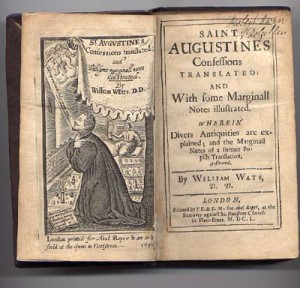
Turner’s Confession shares many of the qualities of Augustine’s: his courageous and honest self-appraisal, and (through it) his expression of unwavering faith. Augustine: “It is He that made us and not we ourselves; nay, we have destroyed ourselves, but He that made us has remade us.” Likewise, Turner’s faith was such that he no longer existed for his own self; he had become nothing but divine instrument.
We know this because the most remarkable thing about Turner’s words, and his rebellion itself, was its fatalism. From his earliest memories, Turner believed himself to be divinely intended “for some great purpose.” Throughout his life he cultivated the persona of a prophet, to the point of returning from a successful escape in order to fulfill his divinely-appointed role. And he knew that whatever the divine intended for him, the outcome was of no consequence. As he heard the Holy Spirit: “Such is your luck, such you are called to see, and let it come rough or smooth, you must surely bare it.”
What other than divine command could account for the futility of his enterprise? Turner was no maniac, but a sane and (for a slave) well-respected man. (Modern students should note that many other antebellum activists also experienced apocalyptic spiritual visions. The moral uplifter Maria Stewart also was visited by the “Holy Spirit,” which likewise proclaimed to her the imminent day of judgment.) Possessed of an “uncommon intelligence,” even whites acknowledged that he had “too much sense” to be made a typical slave. And, indeed, he did not act the slave, or participate in the paternalistic patterns of daily resistance that marked the typical slave experience. “I was not addicted to stealing in my youth,” he claimed, and he avoided “conjuring and such like tricks—for . . . I always spoke of such things with contempt.”
Yet, even more than earlier fomenters of mass violence such as Gabriel or Denmark Vesey, Turner faced insurmountable impediments to success. Stranded in the countryside, he could hope for no alliance from disgruntled plebeian whites in nearby cities. There was no local armory to raid, no port from which to sail to Haiti, and no nearby governor to kidnap and ransom. Neither did Turner leave any statements calling upon the principles of liberty and republicanism, as his predecessors had.

His obstacles were overwhelming. In the case of the German Coast (Louisiana) uprising of 1811, slaves constituted nearly 60 percent of the affected frontier parish. Enslaved people constituted less than half of Turner’s Southampton County, which was also well-established and heavily policed. In short, Turner’s rebellion had no material chance of success, and Turner knew it.
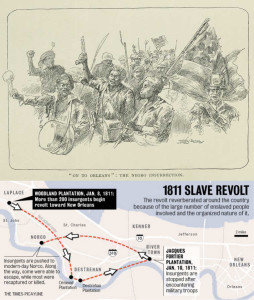
Why, then, would a man a man so resolved seek to hide after his revolution failed? Why surrender? And why tell his story? While whites portrayed the choice as cowardice, Turner could have easily destroyed himself rather than face the gallows. Instead, when discovered “he immediately surrendered, and begged that his life might be spared.” Why? He had no hope of avoiding execution.
I want to suggest that with his surrender Turner had purchased two things: time to tell his story, and an audience to tell it to. I want to suggest that in “confessing,” Nat Turner sought the only victory left to him, which was to leave in the record his own narrative. Like Augustine’s, Turner’s detailed a spiritual journey. Unlike Augustine’s, it had an unmistakable and practical political purpose, which was nothing less than to continue the revolution he had begun.
Only Turner could explain the point of his apparently nihilistic violence, for he had masterminded the scheme, and coaxed his subordinates into behavior even they did not understand. Thomas Gray, the slaveholding white attorney who acted as Turner’s amanuensis for the Confessions, related the scene:
The insurgent slaves had all been destroyed, or apprehended, tried and executed, (with the exception of the leader,) without revealing any thing at all satisfactory, as to the motives which governed them, or the means by which they expected to accomplish their object. Every thing connected with this sad affair was wrapt in mystery, until Nat Turner, the leader of this ferocious band, whose name has resounded throughout our widely extended empire, was captured.
Turner’s role as sole “revelator” left him in command of the narrative. So what did his narrative suggest about the point of the rebellion?
At first glance, the Confession seems stubbornly resistant on this point. The slaves involved in Gabriel’s Richmond conspiracy of 1800 had couched their actions in the terms of Atlantic liberalism, asserting that they had ”as much right to fight for our liberty as any men.” Denmark Vesey, architect of the Charleston conspiracy of 1822, had likewise understood his actions in terms of the revolutionary tradition. He read everything he could “that had any connexion with slavery,” and especially all “that related to St. Domingo.” And he planned his uprising for July 14, Bastille Day.
Testimony of slave rebels in Turner’s revolt offer nothing akin to republican principles. Instead, we have divine visions. Turner appears not so much a figure of the revolutionary black Atlantic as he does a militant prophet of the Second Great Awakening. His politics appear to have been entirely spiritual. Gray may have excised any explicit references Turner may have made to slavery, for this would have been in keeping with his social position and overall purpose. In the absence of anything else, though, we are left with nothing more than this characteristically fatalistic exchange:
[Turner:] I heard a loud noise in the heavens, and the Spirit instantly appeared to me and said the Serpent was loosened, and Christ had laid down the yoke he had borne for the sins of men, and that I should take it on and fight against the Serpent, for the time was fast approaching when the first should be last and the last should be first.
Ques. Do you not find yourself mistaken now?
Ans. Was not Christ crucified.
Powerful moment. Nothing better encapsulates the Confession’s politics. Turner had known that his rebellion was unlikely to succeed in conventional terms, but that did not make him wrong. He had to execute the will of god regardless.
Now, having apparently failed, he could still continue with his purpose. In “confessing,” Turner knew that his words would be retained and transmitted across time and space, shaping forever the way his actions would be understood. Why else speak?
Turner, like Thomas Gray, knew that everyone wanted to hear. “Public curiosity has been on the stretch to understand the origin and progress of this dreadful conspiracy, and the motives which influences its diabolical actors,” Gray wrote. Intended to vindicate the master class whence came its author, Gray’s pamphlet sold well. But Turner—wretched and destitute—used this interest in his story to pursue his aims.
What, then, were those aims? What had been the entire point? If not to spark a revolution on the model of democratic ideals drawn from the revolutionary tradition, what had been the goal?
We have already seen the first answer, in Turner’s invocation of Matthew 20:16: “So the last shall be first, and the first last: for many be called, but few chosen.” Understand that this is nothing short of an invocation of apocalypse. As Turner attested:
And now the Holy Ghost had revealed itself to me, and made plain the miracles it had shown me—For as the blood of Christ had been shed on this earth, and had ascended to heaven for the salvation of sinners, and was now returning to earth again in the form of dew—and as the leaves on the trees bore the impression of the figures I had seen in the heavens, it was plain to me that the Saviour was about to lay down the yoke he had borne for the sins of men, and the great day of judgment was at hand.
Turner apparently hoped that his violence might invoke the Second Coming: the end of time, and the inauguration of a time of perfect justice and perfect peace. He partook of a tradition as old and established as was the apocalyptic tradition of Jesus Christ himself.
Having failed, like Jesus, to have sparked the coming of god’s kingdom on earth, Turner sought to leave behind a potent legacy. Consider Turner’s own recounting of his purpose (my italics):
I took my station in the rear, and as it ’twas my object to carry terror and devastation wherever we went, I placed fifteen or twenty of the best armed and most to be relied on, in front, who generally approached the houses as fast as their horses could run; this was for two purposes, to prevent their escape and strike terror to the inhabitants—on this account I never got to the houses, after leaving Mrs. Whitehead’s, until the murders were committed, except in one case.
To the extent that we can know it, Turner’s object was terror. It was to demonstrate to everyone around that no one was safe so long as slavery remained. According to Gray, Turner was “not instigated by motives of revenge or sudden anger, but the results of long deliberation, and a settled purpose of mind.” And once violence commenced Turner determined that “neither age nor sex was to be spared, (which was invariably adhered to.)”
Turner’s revolution failed. He had sought to “carry terror and devastation” as widely as he could, but had been materially defeated by the overwhelming force of his oppressors. But by telling his story, the terror could continue. By telling his story, Turner could reveal the ”settled purpose of mind” from which he had acted. The purpose of his “confession” was not to admit guilt at all. As Gray notes, “He makes no attempt (as all the other insurgents who were examined did,) to exculpate himself, but frankly acknowledges his full participation in all the guilt of the transaction.” The purpose was to carry on in words the work he had begun with a sword.
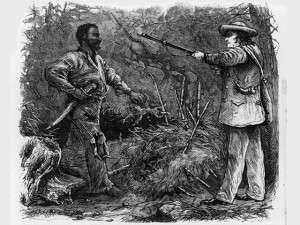
Through Gray, Turner successfully manipulated the insecurities of the master class to broadcast his message. Gray captured Turner’s words in an effort to understand, and thus control, the assault that had been made on his society. But the slave rebel turned Gray’s purpose to his own advantage. Turner may have told his story precisely because this was a way for him to continue the work of terrorism he had begun.
In this, the very impenetrability of Turner’s motives were his greatest weapon, suggesting that murder randomly awaited anyone, benign or cruel, who held slaves as property. Nothing frightened slaveholders more than such apparently purposeless violence. As Gray related:
Whilst every thing upon the surface of society wore a calm and peaceful aspect; whilst not one note of preparation was heard to warn the devoted inhabitants of woe and death, a gloomy fanatic was revolving in the recesses of his own dark, bewildered, and overwrought mind, schemes of indiscriminate massacre to the whites.
What was the proof of Turner’s success? In the short term, his failed revolution brought vicious reprisals. Dozens of blacks were tried without process and executed. Virginia passed new laws forbidding slaves to read or write, preach, and hold meetings. As far away as New Orleans, legislators inspired by the Southampton insurrection tightened old controls on black life, and applied new ones.

But, horrendous as it was, the sweeping campaign of oppression that followed the rebellion was less surprising than the Virginia General Assembly’s next move. As had happened in the wake of Gabriel’s rebellion, some whites questioned retaining an institution so manifestly dangerous. This time, though, the legislature actually considered alternatives. In January of 1832, the Virginia General Assembly began debating a measure to abolish slavery gradually in the state. Extraordinarily, a slave rebel had indirectly brought the abolition of slavery to the floor of the oldest and most powerful slaveholding state of the union.
The measure did not pass. But the story reveals the unmistakable political consequence of a slave rebellion whose politics have been understood as opaque at best, or nihilistic at worst. Turner’s words were picked up, repeated, and translated by white abolitionists such as William Lloyd Garrison and black activists such as Henry Highland Garnet. These figures made Turner’s case repeatedly, setting before the eyes of a public largely indifferent to the plight of the slaves the fearful specter of slave violence.
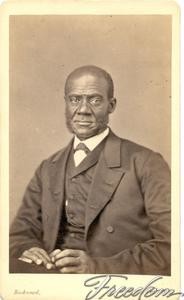
As the abolitionist poet John Greenleaf Whittier wrote:
Oh rouse ye, ere the storm comes forth—
The gathered wrath of God and man—
Like that which wasted Egypt’s earth,
When hail and fire above it ran.
Hear ye no warnings in the air?
Feel ye no earthquake underneath?
Up—up—why will ye slumber where
The sleeper only wakes in death?
Thanks to the wonderful students in my course, Hist2140: History of African Americans to 1865, for their input and insight.
Copyright © AAIHS. May not be reprinted without permission.

Fascinating! Thank you.
Thank you for this post! You do a wonderful job of explaining Turner. I hope you don’t mind that I borrow some of your analysis the next time I teach Turner. Also, I’m currently using Charles F. Irons, The Origins of Proslavery Christianity: White and Black Evangelicals in Colonial and Antebellum Virginia (Chapel Hill: University of North Carolina Press, 2008), and I’d be curious to know your reaction to Irons’ understanding of the Turner interview and of the response to the revolt.
thanks for the question. i have to admit that i’ve not engaged Iron’s fine book as deeply as i would wish, but i think i get the gist of his provocative argument. i can’t take on the notion that the practice of slave religion in Virginia after 1831 inadvertently promoted the basic premises of proslavery thought. but the basic idea — that a hegemonic ideology sought to use culture (religion) to buttress itself — doesn’t sound wrong. i might suggest that the hegemony was perhaps not so complete, at least in the sense that it emerged from anxieties over new forms of antislavery rather than from its own undisputed dominance. this is, i think, a terribly important point about Turner’s rebellion. despite by all standards appearing to be less “political” than previous ones, it took place in a new historical context, in which a new brand of antislavery activist was willing and capable of interpreting the meaning and significance of an act otherwise deemed senseless. this confluence of slave resistance and antislavery ideology wound up being the potent force that helped topple the formal political system, which resulted in secession, war, and eventually emancipation. that there might have been some complicity in this — of the inadvertent sort Irons finds among black preachers, or even of the obvious variety of collaborators — is to be expected of any process as large and as complex as the one that toppled slavery. but it does not alter the basic architecture of that process.
Thanks for this very thoughtful reply Patrick!! Everything you write echoes my own thoughts but your brief and suggestive response raises a question for me. You describe Turner’s confession as a form of religious practice. In your analysis of Turner, religious belief is the phenomenon animating other forms of belief and action. Religion has a primary analytical quality when you describe Turner’s worldview. In your response above, religion is at the use of hegemony (I’m interpreting this to be the varied complex structures that supported and maintained slave society). Please, please forgive me if I’m misreading your post. If I am not, you raise very interesting questions about how historians and scholars of religious studies treat religion relative to issues of ethical and social concern. There is a classic question here of the relationship between ideas to other kinds of phenomena. Again, thank you, thank you for your insight!!! No response needed. You got me thinking. Thanks again!
you’re right, of course, Chernoh. “religion” in my analysis is both a primary driver (of Turner’s actions, in this case) and an epiphenomenon of structures of power relations. personally, i don’t see these as inimical. certainly, Turner experienced his beliefs as innate and intrinsic. so, too, i would offer, do Irons’s black preachers. the critical point, i suppose, is to wonder how Irons’s white evangelicals and political leaders saw it. (here i must demure, not having read Irons closely enough.) for him, belief may approach social control, no? for it is used as an instrument of power. it sounds, though, as if he is sufficiently sensitive to understand that historical actors were unlikely to experience belief in this fashion. in simpler words, “religion” could be utterly and sincerely be experienced as a unrelated to worldly power, and yet nonetheless function as its instrument. this is not to say that belief is mere epiphenomenon — that’s a reductionist materialist take that reduces lived experience to something unrecognizable by historical actors, and manifests the hubris of later generations who presume to know what religion was “really” about. and yet it i would nonetheless argue that belief did bear a relation to power, and that often this relation (perhaps better in the plural) was unfathomed by those who believed. the hard work is the work Irons has essayed, which is to discern the tension between felt belief and the operations of power in specific times and places. thanks be that historian rely on generalization, yet delight in the specific. peace.